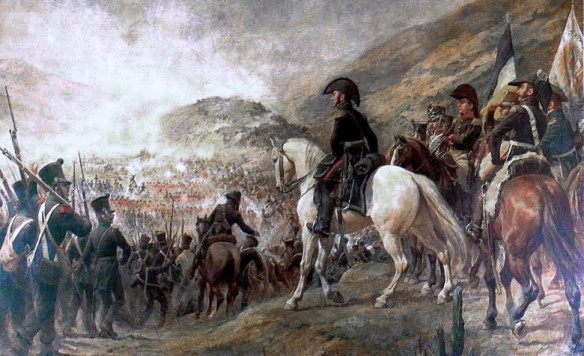Battle of Chacabuco
San Martin divided his army into two divisions. The first, under General Bernardo O’Higgins, was to fix the attention of the Royalist force to their front, whilst the second, under General Soler, was to move around their left flank. Unfortunately, the flanking force experienced a series of delays, and, as the day wore on, O’Higgins found himself confronting the majority of the Royalist army in an exchange of fire over a deep creek. Taking decisive action (although disobeying orders), O’Higgins ordered a general advance and attacked the Royalist line. The line buckled under the attack, allowing O’Higgins’ cavalry to sweep through. The defeated Royalists retreated towards Chacabuco farm. In the meanwhile, San Martin had personally gone to find the flanking force, and with his arrival turned the Royalist retreat into a rout.
Battle of Chacabuco, (Feb. 12, 1817), in the Latin American wars of independence, a victory won by South American patriots over Spanish royalists north of Santiago, Chile. It began the expulsion of the Spaniards from Chile, completed the next year at the Battle of Maipú. After Argentine independence from Spain had been declared in 1816, José de San Martín, leader of the independence movement in southern South America, embarked on the liberation of Chile (January 1817). Beginning in 1810, the independence movement there had been plagued by bitter rivalry between the brothers José Miguel and Juan José Carrera on the one hand and Bernardo O’Higgins on the other. Joined by O’Higgins, San Martín led about 5,000 troops on a difficult 20-day march over the high Andes; he lost about 2,000 men in the cold and high altitudes but managed to surprise the Spaniards. The Spanish general Rafael Maroto mustered only about 1,500 troops to meet the advancing enemy force at Chacabuco. Initially, the Spanish infantry drove back O’Higgins’ contingent, but a successful grenadier charge led by San Martín against the Spanish cavalry gave O’Higgins’ forces time to recover and attack the Spanish flank; the Spaniards were driven into rout. The people of Santiago honoured San Martín as the liberator of Chile and elected him governor, which office he refused in favour of O’Higgins. Before the final victory at Maipú, San Martín’s army sustained a serious defeat by loyalists at Cancha-Rayada, south of Rancagua, in March 1818.
